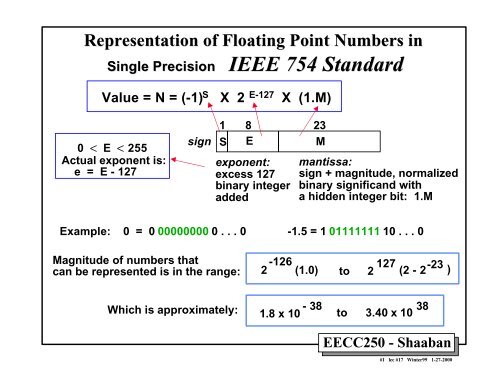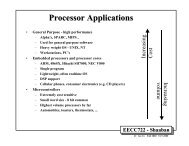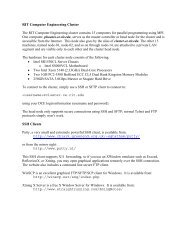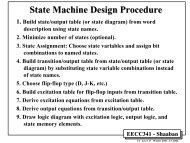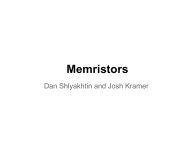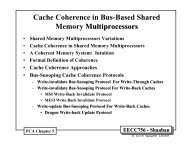Representation of Floating Point Numbers in Single Precision ...
Representation of Floating Point Numbers in Single Precision ...
Representation of Floating Point Numbers in Single Precision ...
You also want an ePaper? Increase the reach of your titles
YUMPU automatically turns print PDFs into web optimized ePapers that Google loves.
<strong>Representation</strong> <strong>of</strong> <strong>Float<strong>in</strong>g</strong> <strong>Po<strong>in</strong>t</strong> <strong>Numbers</strong> <strong>in</strong><br />
S<strong>in</strong>gle <strong>Precision</strong> IEEE 754 Standard<br />
Value = N = (-1) S X 2 E-127 X (1.M)<br />
0 < E < 255<br />
Actual exponent is:<br />
e = E - 127<br />
sign<br />
1 8 23<br />
S E M<br />
exponent:<br />
excess 127<br />
b<strong>in</strong>ary <strong>in</strong>teger<br />
added<br />
mantissa:<br />
sign + magnitude, normalized<br />
b<strong>in</strong>ary significand with<br />
a hidden <strong>in</strong>teger bit: 1.M<br />
Example: 0 = 0 00000000 0 . . . 0 -1.5 = 1 01111111 10 . . . 0<br />
Magnitude <strong>of</strong> numbers that<br />
can be represented is <strong>in</strong> the range: 2 -126 (1.0) to 2 127 (2 - 2 -23 )<br />
Which is approximately: 1.8 x 10 - 38 to 3.40 x 10 38<br />
EECC250 - Shaaban<br />
#1 lec #17 W<strong>in</strong>ter99 1-27-2000
<strong>Representation</strong> <strong>of</strong> <strong>Float<strong>in</strong>g</strong> <strong>Po<strong>in</strong>t</strong> <strong>Numbers</strong> <strong>in</strong><br />
Double <strong>Precision</strong> IEEE 754 Standard<br />
Value = N = (-1) S X 2 E-1023 X (1.M)<br />
0 < E < 2047<br />
Actual exponent is:<br />
e = E - 1023<br />
sign<br />
1 11 52<br />
S E M<br />
exponent:<br />
excess 1023<br />
b<strong>in</strong>ary <strong>in</strong>teger<br />
added<br />
mantissa:<br />
sign + magnitude, normalized<br />
b<strong>in</strong>ary significand with<br />
a hidden <strong>in</strong>teger bit: 1.M<br />
Example: 0 = 0 00000000000 0 . . . 0 -1.5 = 1 01111111111 10 . . . 0<br />
Magnitude <strong>of</strong> numbers that<br />
can be represented is <strong>in</strong> the range: 2 -1022 (1.0) to 2 1023 (2 - 2 - 52 )<br />
Which is approximately: 2.23 x 10 - 308 to 1.8 x 10 308<br />
EECC250 - Shaaban<br />
#2 lec #17 W<strong>in</strong>ter99 1-27-2000
IEEE 754 Format Parameters<br />
S<strong>in</strong>gle <strong>Precision</strong> Double <strong>Precision</strong><br />
p (bits <strong>of</strong> precision) 24 53<br />
Unbiased exponent<br />
e max<br />
127 1023<br />
Unbiased exponent<br />
e m<strong>in</strong><br />
-126 -1022<br />
Exponent bias 127 1023<br />
EECC250 - Shaaban<br />
#3 lec #17 W<strong>in</strong>ter99 1-27-2000
IEEE 754 Special Number <strong>Representation</strong><br />
S<strong>in</strong>gle <strong>Precision</strong> Double <strong>Precision</strong> Number Represented<br />
Exponent Significand Exponent Significand<br />
0 0 0 0 0<br />
0 nonzero 0 nonzero Denormalized number 1<br />
1 to 254 anyth<strong>in</strong>g 1 to 2046 anyth<strong>in</strong>g <strong>Float<strong>in</strong>g</strong> <strong>Po<strong>in</strong>t</strong> Number<br />
255 0 2047 0 Inf<strong>in</strong>ity 2<br />
255 nonzero 2047 nonzero NaN (Not A Number) 3<br />
1<br />
May be returned as a result <strong>of</strong> underflow <strong>in</strong> multiplication<br />
2<br />
Positive divided by zero yields “<strong>in</strong>f<strong>in</strong>ity”<br />
3<br />
Zero divide by zero yields NaN “not a number”<br />
EECC250 - Shaaban<br />
#4 lec #17 W<strong>in</strong>ter99 1-27-2000
<strong>Float<strong>in</strong>g</strong> <strong>Po<strong>in</strong>t</strong> Conversion Example<br />
• The decimal number .75 10 is to be represented <strong>in</strong> the<br />
IEEE 754 32-bit s<strong>in</strong>gle precision format:<br />
Hidden<br />
-2345.125 10 = 0.11 2 (converted to a b<strong>in</strong>ary number)<br />
= 1.1 x 2 -1 (normalized a b<strong>in</strong>ary number)<br />
• The mantissa is positive so the sign S is given by:<br />
S = 0<br />
• The biased exponent E is given by E = e + 127<br />
E = -1 + 127 = 126 10<br />
= 01111110 2<br />
• Fractional part <strong>of</strong> mantissa M:<br />
M = .10000000000000000000000 (<strong>in</strong> 23 bits)<br />
The IEEE 754 s<strong>in</strong>gle precision representation is given by:<br />
0 01111110 10000000000000000000000<br />
S E M<br />
1 bit 8 bits 23 bits<br />
EECC250 - Shaaban<br />
#5 lec #17 W<strong>in</strong>ter99 1-27-2000
<strong>Float<strong>in</strong>g</strong> <strong>Po<strong>in</strong>t</strong> Conversion Example<br />
• The decimal number -2345.125 10 is to be represented <strong>in</strong> the<br />
IEEE 754 32-bit s<strong>in</strong>gle precision format:<br />
-2345.125 10 = -100100101001.001 2 (converted to b<strong>in</strong>ary)<br />
Hidden<br />
= -1.00100101001001 x 2 11 (normalized b<strong>in</strong>ary)<br />
• The mantissa is negative so the sign S is given by:<br />
S = 1<br />
• The biased exponent E is given by E = e + 127<br />
E = 11 + 127 = 138 10<br />
= 10001010 2<br />
• Fractional part <strong>of</strong> mantissa M:<br />
M = .00100101001001000000000 (<strong>in</strong> 23 bits)<br />
The IEEE 754 s<strong>in</strong>gle precision representation is given by:<br />
1 10001010 00100101001001000000000<br />
S E M<br />
1 bit 8 bits 23 bits<br />
EECC250 - Shaaban<br />
#6 lec #17 W<strong>in</strong>ter99 1-27-2000
Basic <strong>Float<strong>in</strong>g</strong> <strong>Po<strong>in</strong>t</strong> Addition Algorithm<br />
Assum<strong>in</strong>g that the operands are already <strong>in</strong> the IEEE 754 format, perform<strong>in</strong>g<br />
float<strong>in</strong>g po<strong>in</strong>t addition: Result = X + Y = (Xm x 2 Xe ) + (Ym x 2 Ye )<br />
<strong>in</strong>volves the follow<strong>in</strong>g steps:<br />
(1) Align b<strong>in</strong>ary po<strong>in</strong>t:<br />
• Initial result exponent: the larger <strong>of</strong> Xe, Ye<br />
• Compute exponent difference: Ye - Xe<br />
• If Ye > Xe Right shift Xm that many positions to form Xm 2 Xe-Ye<br />
• If Xe > Ye Right shift Ym that many positions to form Ym 2 Ye-Xe<br />
(2) Compute sum <strong>of</strong> aligned mantissas:<br />
i.e Xm2 Xe-Ye + Ym or Xm + Xm2 Ye-Xe<br />
(3) If normalization <strong>of</strong> result is needed, then a normalization step follows:<br />
• Left shift result, decrement result exponent (e.g., if result is 0.001xx…) or<br />
• Right shift result, <strong>in</strong>crement result exponent (e.g., if result is 10.1xx…)<br />
Cont<strong>in</strong>ue until MSB <strong>of</strong> data is 1 (NOTE: Hidden bit <strong>in</strong> IEEE Standard)<br />
(4) Check result exponent:<br />
• If larger than maximum exponent allowed return exponent overflow<br />
• If smaller than m<strong>in</strong>imum exponent allowed return exponent underflow<br />
(5) If result mantissa is 0, may need to set the exponent to zero by a special step<br />
to return a proper zero.<br />
EECC250 - Shaaban<br />
#7 lec #17 W<strong>in</strong>ter99 1-27-2000
(1)<br />
(2)<br />
Start<br />
Compare the exponents <strong>of</strong> the two numbers<br />
shift the smaller number to the right until its<br />
exponent matches the larger exponent<br />
Add the significands (mantissas)<br />
Simplified<br />
<strong>Float<strong>in</strong>g</strong> <strong>Po<strong>in</strong>t</strong><br />
Addition<br />
Flowchart<br />
(3)<br />
Normalize the sum, either shift<strong>in</strong>g right and<br />
<strong>in</strong>crement<strong>in</strong>g the exponent or shift<strong>in</strong>g left<br />
and decrement<strong>in</strong>g the exponent<br />
(4)<br />
Overflow or<br />
Underflow ?<br />
Generate exception<br />
or return error<br />
(5)<br />
If mantissa = 0<br />
set exponent to 0<br />
Done<br />
EECC250 - Shaaban<br />
#8 lec #17 W<strong>in</strong>ter99 1-27-2000
<strong>Float<strong>in</strong>g</strong> <strong>Po<strong>in</strong>t</strong> Addition Example<br />
• Add the follow<strong>in</strong>g two numbers represented <strong>in</strong> the IEEE 754 s<strong>in</strong>gle precision<br />
format: X = 2345.125 10<br />
represented as:<br />
0 10001010 00100101001001000000000<br />
to Y = .75 10<br />
represented as:<br />
0 01111110 10000000000000000000000<br />
(1) Align b<strong>in</strong>ary po<strong>in</strong>t:<br />
• Xe > Ye <strong>in</strong>itial result exponent = Ye = 10001010 = 138 10<br />
• Xe - Ye = 10001010 - 01111110 = 00000110 = 12 10<br />
• Shift Ym 12 10 postions to the right to form<br />
Ym 2 Ye-Xe = Ym 2 -12 = 0.00000000000110000000000<br />
(2) Add mantissas:<br />
Xm + Ym 2 -12 = 1.00100101001001000000000<br />
(3) Normailzed? Yes<br />
+ 0.00000000000110000000000 =<br />
1. 00100101001111000000000<br />
(4) Overflow? No. Underflow? No (5) zero result? No<br />
Result 0 10001010 00100101001111000000000<br />
EECC250 - Shaaban<br />
#9 lec #17 W<strong>in</strong>ter99 1-27-2000
IEEE 754 S<strong>in</strong>gle precision Addition Notes<br />
• If the exponents differ by more than 24, the smaller number will be shifted<br />
right entirely out <strong>of</strong> the mantissa field, produc<strong>in</strong>g a zero mantissa.<br />
– The sum will then equal the larger number.<br />
– Such truncation errors occur when the numbers differ by a factor <strong>of</strong> more than<br />
2 24 , which is approximately 1.6 x 10 7 .<br />
– Thus, the precision <strong>of</strong> IEEE s<strong>in</strong>gle precision float<strong>in</strong>g po<strong>in</strong>t arithmetic is<br />
approximately 7 decimal digits.<br />
• Negative mantissas are handled by first convert<strong>in</strong>g to 2's complement and<br />
then perform<strong>in</strong>g the addition.<br />
– After the addition is performed, the result is converted back to sign-magnitude<br />
form.<br />
• When add<strong>in</strong>g numbers <strong>of</strong> opposite sign, cancellation may occur, result<strong>in</strong>g <strong>in</strong><br />
a sum which is arbitrarily small, or even zero if the numbers are equal <strong>in</strong><br />
magnitude.<br />
– Normalization <strong>in</strong> this case may require shift<strong>in</strong>g by the total number <strong>of</strong> bits <strong>in</strong> the<br />
mantissa, result<strong>in</strong>g <strong>in</strong> a large loss <strong>of</strong> accuracy.<br />
• <strong>Float<strong>in</strong>g</strong> po<strong>in</strong>t subtraction is achieved simply by <strong>in</strong>vert<strong>in</strong>g the sign bit and<br />
perform<strong>in</strong>g addition <strong>of</strong> signed mantissas as outl<strong>in</strong>ed above.<br />
EECC250 - Shaaban<br />
#10 lec #17 W<strong>in</strong>ter99 1-27-2000
Basic <strong>Float<strong>in</strong>g</strong> <strong>Po<strong>in</strong>t</strong> Subtraction Algorithm<br />
Assum<strong>in</strong>g that the operands are already <strong>in</strong> the IEEE 754 format, perform<strong>in</strong>g<br />
float<strong>in</strong>g po<strong>in</strong>t addition: Result = X - Y = (Xm x 2 Xe ) - (Ym x 2 Ye )<br />
<strong>in</strong>volves the follow<strong>in</strong>g steps:<br />
(1) Align b<strong>in</strong>ary po<strong>in</strong>t:<br />
• Initial result exponent: the larger <strong>of</strong> Xe, Ye<br />
• Compute exponent difference: Ye - Xe<br />
• If Ye > Xe Right shift Xm that many positions to form Xm 2 Xe-Ye<br />
• If Xe > Ye Right shift Ym that many positions to form Ym 2 Ye-Xe<br />
(2) Subtract the aligned mantissas:<br />
i.e Xm2 Xe-Ye - Ym or Xm - Xm2 Ye-Xe<br />
(3) If normalization <strong>of</strong> result is needed, then a normalization step follows:<br />
• Left shift result, decrement result exponent (e.g., if result is 0.001xx…) or<br />
• Right shift result, <strong>in</strong>crement result exponent (e.g., if result is 10.1xx…)<br />
Cont<strong>in</strong>ue until MSB <strong>of</strong> data is 1 (NOTE: Hidden bit <strong>in</strong> IEEE Standard)<br />
(4) Check result exponent:<br />
• If larger than maximum exponent allowed return exponent overflow<br />
• If smaller than m<strong>in</strong>imum exponent allowed return exponent underflow<br />
(5) If result mantissa is 0, may need to set the exponent to zero by a special step<br />
to return a proper zero.<br />
EECC250 - Shaaban<br />
#11 lec #17 W<strong>in</strong>ter99 1-27-2000
(1)<br />
(2)<br />
Start<br />
Compare the exponents <strong>of</strong> the two numbers<br />
shift the smaller number to the right until its<br />
exponent matches the larger exponent<br />
Subtract the mantissas<br />
Simplified<br />
<strong>Float<strong>in</strong>g</strong> <strong>Po<strong>in</strong>t</strong><br />
Subtraction<br />
Flowchart<br />
(3)<br />
Normalize the sum, either shift<strong>in</strong>g right and<br />
<strong>in</strong>crement<strong>in</strong>g the exponent or shift<strong>in</strong>g left<br />
and decrement<strong>in</strong>g the exponent<br />
(4)<br />
Overflow or<br />
Underflow ?<br />
Generate exception<br />
or return error<br />
(5)<br />
If mantissa = 0<br />
set exponent to 0<br />
Done<br />
EECC250 - Shaaban<br />
#12 lec #17 W<strong>in</strong>ter99 1-27-2000
Basic <strong>Float<strong>in</strong>g</strong> <strong>Po<strong>in</strong>t</strong> Multiplication Algorithm<br />
Assum<strong>in</strong>g that the operands are already <strong>in</strong> the IEEE 754 format, perform<strong>in</strong>g<br />
float<strong>in</strong>g po<strong>in</strong>t multiplication:<br />
Result = R = X * Y = (-1) Xs (Xm x 2 Xe ) * (-1) Ys (Ym x 2 Ye )<br />
<strong>in</strong>volves the follow<strong>in</strong>g steps:<br />
(1) If one or both operands is equal to zero, return the result as zero, otherwise:<br />
(2) Compute the sign <strong>of</strong> the result Xs XOR Ys<br />
(3) Compute the mantissa <strong>of</strong> the result:<br />
• Multiply the mantissas: Xm * Ym<br />
• Round the result to the allowed number <strong>of</strong> mantissa bits<br />
(4) Compute the exponent <strong>of</strong> the result:<br />
Result exponent = biased exponent (X) + biased exponent (Y) - bias<br />
(5) Normalize if needed, by shift<strong>in</strong>g mantissa right, <strong>in</strong>crement<strong>in</strong>g result exponent.<br />
(6) Check result exponent for overflow/underflow:<br />
• If larger than maximum exponent allowed return exponent overflow<br />
• If smaller than m<strong>in</strong>imum exponent allowed return exponent underflow<br />
EECC250 - Shaaban<br />
#13 lec #17 W<strong>in</strong>ter99 1-27-2000
(1)<br />
Start<br />
Is one/both<br />
operands =0?<br />
Simplified <strong>Float<strong>in</strong>g</strong> <strong>Po<strong>in</strong>t</strong><br />
Multiplication Flowchart<br />
Set the result to zero:<br />
exponent = 0<br />
(2)<br />
(3)<br />
(4)<br />
(5)<br />
Compute sign <strong>of</strong> result: Xs XOR Ys<br />
Multiply the mantissas<br />
Round or truncate the result mantissa<br />
Compute exponent:<br />
biased exp.(X) + biased exp.(Y) - bias<br />
Normalize mantissa if needed<br />
(6)<br />
Generate exception<br />
or return error<br />
Overflow or<br />
Underflow?<br />
Done<br />
EECC250 - Shaaban<br />
#14 lec #17 W<strong>in</strong>ter99 1-27-2000
<strong>Float<strong>in</strong>g</strong> <strong>Po<strong>in</strong>t</strong> Multiplication Example<br />
• Multiply the follow<strong>in</strong>g two numbers represented <strong>in</strong> the IEEE 754 s<strong>in</strong>gle<br />
precision format: X = -18 10<br />
represented as:<br />
1 10000011 00100000000000000000000<br />
and Y = 9.5 10<br />
represented as:<br />
0 10000010 00110000000000000000000<br />
(1) Value <strong>of</strong> one or both operands = 0? No, cont<strong>in</strong>ue with step 2<br />
(2) Compute the sign: S = Xs XOR Ys = 1 XOR 0 = 1<br />
(3) Multiply the mantissas: The product <strong>of</strong> the 24 bit mantissas is 48 bits with<br />
two bits to the left <strong>of</strong> the b<strong>in</strong>ary po<strong>in</strong>t:<br />
Truncate to 24 bits:<br />
(01).0101011000000….000000<br />
hidden → (1).01010110000000000000000<br />
(4) Compute exponent <strong>of</strong> result:<br />
Xe + Ye - 127 10 = 1000 0011 + 1000 0010 - 0111111 = 1000 0110<br />
(5) Result mantissa needs normalization? No<br />
(6) Overflow? No. Underflow? No<br />
Result 1 10000110 01010101100000000000000<br />
EECC250 - Shaaban<br />
#15 lec #17 W<strong>in</strong>ter99 1-27-2000
IEEE 754 S<strong>in</strong>gle precision Multiplication Notes<br />
• Round<strong>in</strong>g occurs <strong>in</strong> float<strong>in</strong>g po<strong>in</strong>t multiplication when the mantissa <strong>of</strong> the<br />
product is reduced from 48 bits to 24 bits.<br />
– The least significant 24 bits are discarded.<br />
• Overflow occurs when the sum <strong>of</strong> the exponents exceeds 127, the largest<br />
value which is def<strong>in</strong>ed <strong>in</strong> bias-127 exponent representation.<br />
– When this occurs, the exponent is set to 128 (E = 255) and the mantissa is set<br />
to zero <strong>in</strong>dicat<strong>in</strong>g + or - <strong>in</strong>f<strong>in</strong>ity.<br />
• Underflow occurs when the sum <strong>of</strong> the exponents is more negative than -<br />
126, the most negative value which is def<strong>in</strong>ed <strong>in</strong> bias-127 exponent<br />
representation.<br />
– When this occurs, the exponent is set to -127 (E = 0).<br />
– If M = 0, the number is exactly zero.<br />
– If M is not zero, then a denormalized number is <strong>in</strong>dicated which has an<br />
exponent <strong>of</strong> -127 and a hidden bit <strong>of</strong> 0.<br />
– The smallest such number which is not zero is 2 -149 . This number reta<strong>in</strong>s only<br />
a s<strong>in</strong>gle bit <strong>of</strong> precision <strong>in</strong> the rightmost bit <strong>of</strong> the mantissa.<br />
EECC250 - Shaaban<br />
#16 lec #17 W<strong>in</strong>ter99 1-27-2000
Basic <strong>Float<strong>in</strong>g</strong> <strong>Po<strong>in</strong>t</strong> Division Algorithm<br />
Assum<strong>in</strong>g that the operands are already <strong>in</strong> the IEEE 754 format, perform<strong>in</strong>g<br />
float<strong>in</strong>g po<strong>in</strong>t multiplication:<br />
Result = R = X / Y = (-1) Xs (Xm x 2 Xe ) / (-1) Ys (Ym x 2 Ye )<br />
<strong>in</strong>volves the follow<strong>in</strong>g steps:<br />
(1) If the divisor Y is zero return “Inf<strong>in</strong>ity”, if both are zero return “NaN”<br />
(2) Compute the sign <strong>of</strong> the result Xs XOR Ys<br />
(3) Compute the mantissa <strong>of</strong> the result:<br />
– The dividend mantissa is extended to 48 bits by add<strong>in</strong>g 0's to the right <strong>of</strong> the least<br />
significant bit.<br />
– When divided by a 24 bit divisor Ym, a 24 bit quotient is produced.<br />
(4) Compute the exponent <strong>of</strong> the result:<br />
Result exponent = [biased exponent (X) - biased exponent (Y)] + bias<br />
(5) Normalize if needed, by shift<strong>in</strong>g mantissa left, decrement<strong>in</strong>g result exponent.<br />
(6) Check result exponent for overflow/underflow:<br />
• If larger than maximum exponent allowed return exponent overflow<br />
• If smaller than m<strong>in</strong>imum exponent allowed return exponent underflow<br />
EECC250 - Shaaban<br />
#17 lec #17 W<strong>in</strong>ter99 1-27-2000
IEEE 754 Error Round<strong>in</strong>g<br />
• In <strong>in</strong>teger arithmetic, the result <strong>of</strong> an operation is well-def<strong>in</strong>ed:<br />
– Either the exact result is obta<strong>in</strong>ed or overflow occurs and the result cannot<br />
be represented.<br />
• In float<strong>in</strong>g po<strong>in</strong>t arithmetic, round<strong>in</strong>g errors occur as a result <strong>of</strong> the limited<br />
precision <strong>of</strong> the mantissa. For example, consider the average <strong>of</strong> two float<strong>in</strong>g<br />
po<strong>in</strong>t numbers with identical exponents, but mantissas which differ by 1.<br />
Although the mathematical operation is well-def<strong>in</strong>ed and the result is with<strong>in</strong> the<br />
range <strong>of</strong> representable numbers, the average <strong>of</strong> two adjacent float<strong>in</strong>g po<strong>in</strong>t<br />
values cannot be represented exactly.<br />
• The IEEE FPS def<strong>in</strong>es four round<strong>in</strong>g rules for choos<strong>in</strong>g the closest float<strong>in</strong>g po<strong>in</strong>t<br />
when a round<strong>in</strong>g error occurs:<br />
– RN - Round to Nearest. Break ties by choos<strong>in</strong>g the least significant bit = 0.<br />
– RZ - Round toward Zero. Same as truncation <strong>in</strong> sign-magnitude.<br />
– RP - Round toward Positive <strong>in</strong>f<strong>in</strong>ity.<br />
– RM - Round toward M<strong>in</strong>us <strong>in</strong>f<strong>in</strong>ity. Same as truncation <strong>in</strong> <strong>in</strong>teger 2's<br />
complement arithmetic.<br />
• RN is generally preferred and <strong>in</strong>troduces less systematic error than the other<br />
rules.<br />
EECC250 - Shaaban<br />
#18 lec #17 W<strong>in</strong>ter99 1-27-2000
<strong>Float<strong>in</strong>g</strong> <strong>Po<strong>in</strong>t</strong> Error Round<strong>in</strong>g Observations<br />
• The absolute error <strong>in</strong>troduced by round<strong>in</strong>g is the actual difference between the<br />
exact value and the float<strong>in</strong>g po<strong>in</strong>t representation.<br />
• The size <strong>of</strong> the absolute error is proportional to the magnitude <strong>of</strong> the number.<br />
– For numbers <strong>in</strong> s<strong>in</strong>gle <strong>Precision</strong> IEEE 754 format, the absolute error is<br />
less than 2 -24 .<br />
– The largest absolute round<strong>in</strong>g error occurs when the exponent is 127 and<br />
is approximately 10 31 s<strong>in</strong>ce 2 -24 .2 127 = 10 31<br />
• The relative error is the absolute error divided by the magnitude <strong>of</strong> the<br />
number which is approximated. For normalized float<strong>in</strong>g po<strong>in</strong>t numbers, the<br />
relative error is approximately 10 -7<br />
• Round<strong>in</strong>g errors affect the outcome <strong>of</strong> float<strong>in</strong>g po<strong>in</strong>t computations <strong>in</strong> several<br />
ways:<br />
– Exact comparison <strong>of</strong> float<strong>in</strong>g po<strong>in</strong>t variables <strong>of</strong>ten produces <strong>in</strong>correct results.<br />
<strong>Float<strong>in</strong>g</strong> variables should not be used as loop counters or loop <strong>in</strong>crements.<br />
– Operations performed <strong>in</strong> different orders may give different results. On many<br />
computers, a+b may differ from b+a and (a+b)+c may differ from a+(b+c).<br />
– Errors accumulate over time. While the relative error for a s<strong>in</strong>gle operation <strong>in</strong><br />
s<strong>in</strong>gle precision float<strong>in</strong>g po<strong>in</strong>t is about 10 -7 , algorithms which iterate many<br />
times may experience an accumulation <strong>of</strong> errors which is much larger.<br />
EECC250 - Shaaban<br />
#19 lec #17 W<strong>in</strong>ter99 1-27-2000
68000 FLOATING POINT ADD/SUBTRACT<br />
(FFPADD/FFPSUB) Subrout<strong>in</strong>e<br />
*************************************************************<br />
* FFPADD/FFPSUB *<br />
* FAST FLOATING POINT ADD/SUBTRACT *<br />
* *<br />
* FFPADD/FFPSUB - FAST FLOATING POINT ADD AND SUBTRACT *<br />
* *<br />
* INPUT: *<br />
* FFPADD *<br />
* D6 - FLOATING POINT ADDEND *<br />
* D7 - FLOATING POINT ADDER *<br />
* FFPSUB *<br />
* D6 - FLOATING POINT SUBTRAHEND *<br />
* D7 - FLOATING POINT MINUEND *<br />
* *<br />
* OUTPUT: *<br />
* D7 - FLOATING POINT ADD RESULT *<br />
* *<br />
* CONDITION CODES: *<br />
* N - RESULT IS NEGATIVE *<br />
* Z - RESULT IS ZERO *<br />
* V - OVERFLOW HAS OCCURED *<br />
* C - UNDEFINED *<br />
* X - UNDEFINED<br />
* (C) COPYRIGHT 1980 BY MOTOROLA INC. *<br />
EECC250 - Shaaban<br />
#20 lec #17 W<strong>in</strong>ter99 1-27-2000
* REGISTERS D3 THRU D5 ARE VOLATILE *<br />
* *<br />
* CODE SIZE: 228 BYTES STACK WORK AREA: 0 BYTES *<br />
* *<br />
* NOTES: *<br />
* 1) ADDEND/SUBTRAHEND UNALTERED (D6). *<br />
* 2) UNDERFLOW RETURNS ZERO AND IS UNFLAGGED. *<br />
* 3) OVERFLOW RETURNS THE HIGHEST VALUE WITH THE *<br />
* CORRECT SIGN AND THE 'V' BIT SET IN THE CCR. *<br />
* *<br />
* TIME: (8 MHZ NO WAIT STATES ASSUMED) *<br />
* *<br />
* COMPOSITE AVERAGE 20.625 MICROSECONDS *<br />
* *<br />
* ADD: ARG1=0 7.75 MICROSECONDS *<br />
* ARG2=0 5.25 MICROSECONDS *<br />
* *<br />
* LIKE SIGNS 14.50 - 26.00 MICROSECONDS *<br />
* AVERAGE 18.00 MICROSECONDS *<br />
* UNLIKE SIGNS 20.13 - 54.38 MICROCECONDS *<br />
* AVERAGE 22.00 MICROSECONDS *<br />
* *<br />
* SUBTRACT: ARG1=0 4.25 MICROSECONDS *<br />
* ARG2=0 9.88 MICROSECONDS *<br />
* *<br />
* LIKE SIGNS 15.75 - 27.25 MICROSECONDS *<br />
* AVERAGE 19.25 MICROSECONDS *<br />
* UNLIKE SIGNS 21.38 - 55.63 MICROSECONDS *<br />
* AVERAGE 23.25 MICROSECONDS *<br />
*<br />
EECC250 - Shaaban<br />
#21 lec #17 W<strong>in</strong>ter99 1-27-2000
************************<br />
* SUBTRACT ENTRY POINT *<br />
************************<br />
FFPSUB MOVE.B D6,D4 TEST ARG1<br />
BEQ.S FPART2 RETURN ARG2 IF ARG1 ZERO<br />
EOR.B #$80,D4 INVERT COPIED SIGN OF ARG1<br />
BMI.S FPAMI1 BRANCH ARG1 MINUS<br />
* + ARG1<br />
MOVE.B D7,D5 COPY AND TEST ARG2<br />
BMI.S FPAMS BRANCH ARG2 MINUS<br />
BNE.S FPALS BRANCH POSITIVE NOT ZERO<br />
BRA.S FPART1 RETURN ARG1 SINCE ARG2 IS ZERO<br />
*******************<br />
* ADD ENTRY POINT *<br />
*******************<br />
FFPADD MOVE.B D6,D4 TEST ARGUMENT1<br />
BMI.S FPAMI1 BRANCH IF ARG1 MINUS<br />
BEQ.S FPART2 RETURN ARG2 IF ZERO<br />
* + ARG1<br />
MOVE.B D7,D5 TEST ARGUMENT2<br />
BMI.S FPAMS BRANCH IF MIXED SIGNS<br />
BEQ.S FPART1 ZERO SO RETURN ARGUMENT1<br />
EECC250 - Shaaban<br />
#22 lec #17 W<strong>in</strong>ter99 1-27-2000
* +ARG1 +ARG2<br />
* -ARG1 -ARG2<br />
FPALS SUB.B D4,D5 TEST EXPONENT MAGNITUDES<br />
BMI.S FPA2LT BRANCH ARG1 GREATER<br />
MOVE.B D7,D4<br />
SETUP STRONGER S+EXP IN D4<br />
* ARG1EXP
* ADD SAME SIGN OVERFLOW NORMALIZATION<br />
FPA2GC ROXR.L #1,D7<br />
ADD.B #1,D4<br />
SHIFT CARRY BACK INTO RESULT<br />
ADD ONE TO EXPONENT<br />
BVS.S FPA2OS BRANCH OVERFLOW<br />
BCC.S FPARSR BRANCH IF NO EXPONENT OVERFLOW<br />
FPA2OS MOVEQ #-1,D7 CREATE ALL ONES<br />
SUB.B #1,D4<br />
MOVE.B D4,D7<br />
BACK TO HIGHEST EXPONENT+SIGN<br />
REPLACE IN RESULT<br />
* OR.B #$02,CCR SHOW OVERFLOW OCCURRED<br />
DC.L<br />
RTS<br />
$003C0002 ****ASSEMBLER ERROR****<br />
RETURN TO CALLER<br />
* RETURN ARGUMENT1<br />
FPART1 MOVE.L D6,D7<br />
MOVE.B D4,D7<br />
RTS<br />
MOVE IN AS RESULT<br />
MOVE IN PREPARED SIGN+EXPONENT<br />
RETURN TO CALLER<br />
* RETURN ARGUMENT2<br />
FPART2 TST.B D7<br />
RTS<br />
TEST FOR RETURNED VALUE<br />
RETURN TO CALLER<br />
EECC250 - Shaaban<br />
#24 lec #17 W<strong>in</strong>ter99 1-27-2000
* -ARG1EXP > -ARG2EXP<br />
* +ARG1EXP > +ARG2EXP<br />
FPA2LT CMP.B #-24,D5 ? ARGUMENTS WITHIN RANGE<br />
BLE.S FPART1 NOPE, RETURN LARGER<br />
NEG.B D5<br />
MOVE.L D6,D3<br />
CLR.B D7<br />
LSR.L D5,D7<br />
CHANGE DIFFERENCE TO POSITIVE<br />
SETUP LARGER VALUE<br />
CLEAN OFF SIGN+EXPONENT<br />
SHIFT TO SAME MAGNITUDE<br />
MOVE.B #$80,D3 FORCE CARRY IF LSB-1 ON<br />
ADD.L D3,D7<br />
ADD ARGUMENTS<br />
BCS.S FPA2GC BRANCH IF CARRY PRODUCED<br />
MOVE.B D4,D7<br />
RTS<br />
RESTORE SIGN/EXPONENT<br />
RETURN TO CALLER<br />
* -ARG1<br />
FPAMI1 MOVE.B D7,D5 TEST ARG2'S SIGN<br />
BMI.S FPALS BRANCH FOR LIKE SIGNS<br />
BEQ.S FPART1 IF ZERO RETURN ARGUMENT1<br />
EECC250 - Shaaban<br />
#25 lec #17 W<strong>in</strong>ter99 1-27-2000
* -ARG1 +ARG2<br />
* +ARG1 -ARG2<br />
FPAMS MOVEQ #-128,D3 CREATE A CARRY MASK ($80)<br />
* ARG1
* MIXED SIGNS NORMALIZE<br />
FPANOR MOVE.B D4,D5<br />
FPANRM CLR.B D7<br />
SUB.B #1,D4<br />
SAVE CORRECT SIGN<br />
CLEAR SUBTRACT RESIDUE<br />
MAKE UP FOR FIRST SHIFT<br />
CMP.L #$00007FFF,D7 ? SMALL ENOUGH FOR SWAP<br />
BHI.S FPAXQN BRANCH NOPE<br />
SWAP.W D7 SHIFT LEFT 16 BITS REAL FAST<br />
SUB.B #16,D4 MAKE UP FOR 16 BIT SHIFT<br />
FPAXQN ADD.L D7,D7<br />
DBMI<br />
EOR.B D4,D5<br />
SHIFT UP ONE BIT<br />
D4,FPAXQN DECREMENT AND BRANCH IF POSITIVE<br />
? SAME SIGN<br />
BMI.S FPAZRO BRANCH UNDERFLOW TO ZERO<br />
MOVE.B D4,D7 RESTORE SIGN/EXPONENT<br />
BEQ.S FPAZRO RETURN ZERO IF EXPONENT<br />
UNDERFLOWED<br />
RTS<br />
RETURN TO CALLER<br />
* EXPONENT UNDERFLOWED - RETURN ZERO<br />
FPAZRO MOVEQ.L #0,D7 CREATE A TRUE ZERO<br />
RTS RETURN TO THE CALLER<br />
EECC250 - Shaaban<br />
#27 lec #17 W<strong>in</strong>ter99 1-27-2000
* ARG1 > ARG2<br />
FPATLT CMP.B #-24,D5 ? ARG1 >> ARG2<br />
BLE.S FPART1 RETURN IT IF SO<br />
NEG.B D5 ABSOLUTIZE DIFFERENCE<br />
MOVE.L D7,D3 MOVE ARG2 AS LOWER VALUE<br />
MOVE.L D6,D7 SETUP ARG1 AS HIGH<br />
MOVE.B #$80,D7 SETUP ROUNDING BIT<br />
BRA.S FPAMSS PERFORM THE ADDITION<br />
* EQUAL MAGNITUDES<br />
FPAEQ MOVE.B D7,D5 SAVE ARG1 SIGN<br />
EXG.L D5,D4<br />
MOVE.B D6,D7<br />
SUB.L D6,D7<br />
SWAP ARG2 WITH ARG1 S+EXP<br />
INSURE SAME LOW BYTE<br />
OBTAIN DIFFERENCE<br />
BEQ.S FPAZRO RETURN ZERO IF IDENTICAL<br />
BPL.S FPANOR BRANCH IF ARG2 BIGGER<br />
NEG.L D7 CORRECT DIFFERENCE TO POSITIVE<br />
MOVE.B D5,D4<br />
USE ARG2'S SIGN+EXPONENT<br />
BRA.S FPANRM AND GO NORMALIZE<br />
END<br />
* (C) COPYRIGHT 1980 BY MOTOROLA INC. *<br />
EECC250 - Shaaban<br />
#28 lec #17 W<strong>in</strong>ter99 1-27-2000


